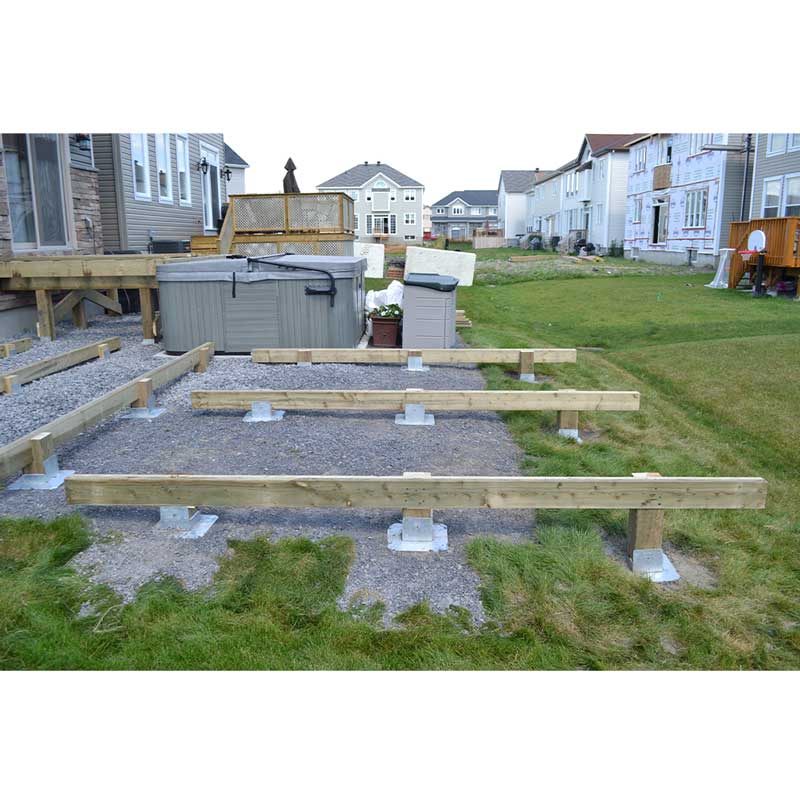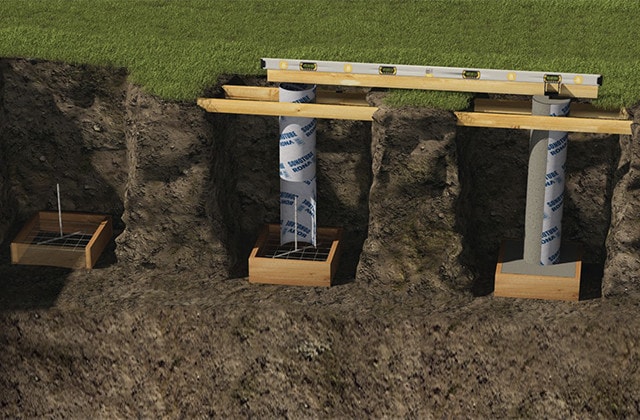Choosing the Right Deck Footings for Stability and Durability
When it comes to constructing a deck, among the most critical choices you will certainly make is choosing the appropriate grounds for stability and durability. The long life and security of your deck depend heavily on the kind of footings you pick, as they give the important support and security to endure the examination of time. With a myriad of choices offered, it can be frustrating to figure out which footings are best matched for your specific needs. In this conversation, we will check out the various sorts of deck footings, think about the essential aspects to weigh when deciding, and look into the benefits and drawbacks of various options. By the end, you will have a more clear understanding of the options handy and be better outfitted to make a notified decision for your deck task.
Kinds Of Deck Footings
These grounds consist of a cylindrical opening filled with concrete, which offers a solid foundation for the deck blog posts. Concrete pier footings are reasonably easy to install and provide exceptional security, making them a preferred choice for many deck tasks.
These grounds are set up by screwing them right into the ground, which develops a safe structure for the deck. They also permit for very easy change and progressing of the deck if needed.
Alternatively, some building contractors choose for precast concrete footings. These footings are made from durable concrete and can be found in different sizes and shapes to fit different deck designs. Precast concrete footings are hassle-free to install and provide a stable base for the deck structure.
Finally, another alternative is the post-in-anchor ground system. This sort of footing entails driving a metal anchor right into the ground and affixing it to the deck blog post. It uses flexibility in terms of placing the deck blog posts and is appropriate for decks with lightweight structures.
When choosing the appropriate kind of deck ground, it is vital to take into consideration variables such as dirt conditions, deck tons, and local structure codes (Deck Footings). Consulting with a specialist contractor or structural designer can aid guarantee the appropriate ground is selected for a steady and secure deck
Factors to Take Into Consideration When Selecting Footings
When picking the ideal footings for a deck, it is essential to thoroughly think about various factors such as soil conditions, deck lots, and adherence to neighborhood building regulations. These elements play a significant role in making certain the security and longevity of the deck framework.
One of the primary factors to take into consideration is the soil conditions. The kind of soil on which the deck will certainly be constructed determines the kind of footings needed. For example, decks improved loosened or sandy soils might call for much deeper footings to provide appropriate support and stop settling. On the other hand, decks developed on clay or expansive soils may call for footings that can suit the dirt's tendency to broaden and contract.
One more important factor is the deck load. The weight of the deck, consisting of the products used and any potential real-time loads such as furnishings or gatherings, must be thought about when selecting grounds. The footings have to be developed to bear the weight of the deck and disperse it evenly to stop any type of architectural concerns or failings.
Lastly, adherence to neighborhood structure codes is vital. Structure codes vary from area to area, and it is necessary to abide by the particular requirements established by the neighborhood authorities. Deck Footings. These codes ensure that the deck is developed securely and meets the essential requirements for structural honesty and load-bearing ability
Concrete Footings: Cons and pros

Concrete footings provide numerous benefits and drawbacks when made use of as the foundation for a deck. On the silver lining, concrete grounds supply outstanding security and toughness. Concrete is a rigid and strong product that can sustain heavy loads and endure various climate condition. It also has a long life expectancy, making it a dependable option for long-lasting use.
One more advantage of concrete footings is their adaptability. They can be put a fantastic read into different sizes and shapes to fit different deck layouts and setups. Concrete footings can be tailored to fit the details demands and demands of the deck framework.
Nonetheless, there are also some drawbacks to making use of concrete grounds. One major disadvantage is the expense and labor associated with their installment. Concrete footings require excavation and frequently need the assistance of hefty equipment. This can raise the general price of the deck task and may need specialist support.

Helical Piers Vs. Sonotubes: Which Is Better?
In thinking about the foundation alternatives for a deck, the comparison between helical piers and sonotubes is critical in figuring out the remarkable selection. They are turned into the ground utilizing hydraulic machinery, providing a steady and sturdy structure for the deck.
When it comes to stability and durability, helical piers have the upper hand. The helical plates on the piers create a strong hold with the soil, shifting or protecting against any kind of activity of the deck. This is particularly advantageous in locations with unsteady or changing soil problems. Sonotubes, on the other hand, rely solely on the concrete filling for security, which may not use the exact same degree of strength and resistance.
In regards to installment, helical piers are fairly simpler and faster to mount contrasted to sonotubes. The hydraulic machinery made use of to turn the piers right into the ground ensures a reliable and fast process. Sonotubes, on the other hand, call for digging openings and putting concrete, which can be lengthy and labor-intensive.
In addition, helical piers are an even more versatile option. They can be utilized in numerous dirt conditions and can be readjusted or enhanced if needed. Sonotubes, on the other hand, might require added support, such as rebar, in specific soil conditions or locations with high tons needs.
Selecting the Right Footings for Your Deck's Measurements
For ideal architectural stability, it is vital to thoroughly choose the proper footings that align with the dimensions of your deck. The measurements of your deck, including its length, size, and elevation, play a significant function in establishing the kind and size of grounds needed.
When choosing grounds for your deck, it is essential to take into consideration the load-bearing ability of the soil. The weight of the deck, incorporated with the weight of any type of furnishings or people on it, puts in a considerable pressure on the grounds (Deck Footings). Consequently, it is essential to select grounds that can sufficiently sustain this weight without shifting or sinking in time.
Bigger decks with greater measurements need larger grounds to offer adequate security and assistance. The form of the footings, whether they are rounded or square, depends on the style and design of the deck.
Verdict
Finally, picking the best deck footings is vital for making sure security and resilience. Aspects such as the kind of grounds, the deck's measurements, and the advantages and disadvantages of various alternatives need to be taken More Info into consideration. Concrete grounds supply stamina and long life, but might be much more pricey and lengthy to install. Helical piers and link sonotubes have their own advantages and disadvantages. Ultimately, choosing the appropriate grounds for your deck's certain requirements is necessary for a successful and resilient structure.
These grounds are composed of a cylindrical opening loaded with concrete, which supplies a strong foundation for the deck messages. Concrete pier grounds are reasonably simple to install and use outstanding security, making them a prominent choice for lots of deck projects.
Precast concrete footings are practical to set up and supply a stable base for the deck framework.
It uses versatility in terms of positioning the deck posts and is appropriate for decks with light-weight structures.
Concrete footings use several benefits and drawbacks when used as the foundation for a deck.